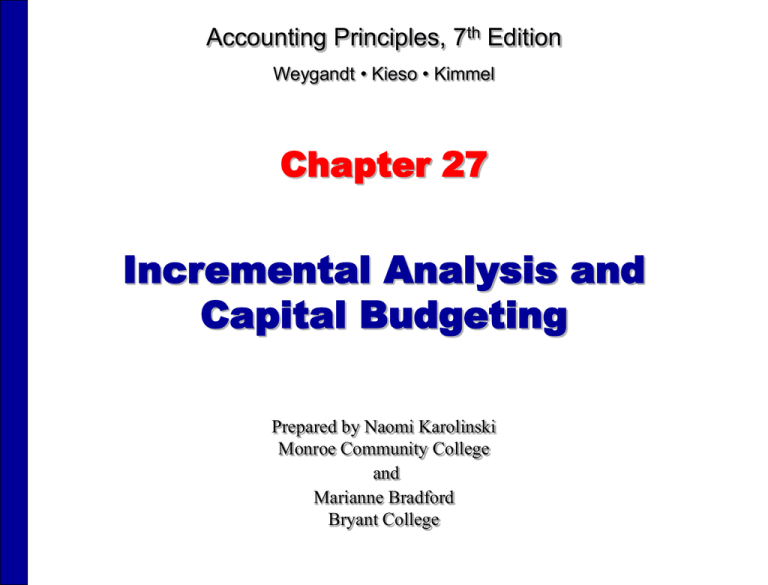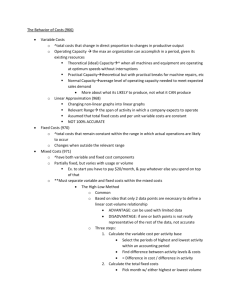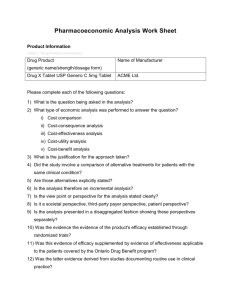
Accounting Principles, 7th Edition
Weygandt • Kieso • Kimmel
Chapter 27
Incremental Analysis and
Capital Budgeting
Prepared by Naomi Karolinski
Monroe Community College
and
Marianne Bradford
Bryant College
CHAPTER 27
INCREMENTAL ANALYSIS
AND CAPITAL BUDGETING
After studying this chapter, you should be able to:
1 Identify the steps in management’s decision-making
process.
2 Describe the concept of incremental analysis.
3 Identify the relevant costs in accepting an order at a
special price.
4 Identify the relevant costs in a make-or-buy decision.
5 Give the decision rule for whether to sell or process
materials further.
6 Identify the factors to be considered in retaining or
replacing equipment.
CHAPTER 27
INCREMENTAL ANALYSIS
AND CAPITAL BUDGETING
After studying this chapter, you should be able to:
7
Explain the relevant factors in deciding
whether to eliminate an unprofitable segment.
8
Determine which products to make and sell
when a company’s resources are limited.
9
Contrast the annual rate of return and cash
payback techniques in capital budgeting.
10
Distinguish between the net present value and
internal rate of return methods.
Management’s DecisionMaking Process
Study Objective 1
Management's decision-making process
frequently involves the following steps:
1) Identify the problem and assign responsibility
2) Determine and evaluate possible
courses of action
3) Make a decision
4) Review results of the decision
Incremental Analysis
Study Objective 2
• Business decisions involve a choice among
alternative courses of action.
• In making such decisions, management ordinarily
considers both financial and nonfinancial
information.
• The process used to identify the financial data that
change under alternative courses of action is called
incremental analysis.
Incremental Analysis
• Incremental analysis includes the probable effects of
the decision on future earnings.
• Data for incremental analysis involves estimates and
uncertainty.
• Gathering data may involve market analysts,
engineers, and accountants.
• In incremental analysis, both costs and revenues may
change. However, in some cases:
–
–
(1) variable costs may not change under
the alternative courses of action, and
(2) fixed costs do change
Basic Approach in Incremental
Analysis
The basic approach in incremental analysis is
illustrated in the following example:
Alternative
A
Revenues
Costs
Net income
$125,000
100,000
$ 25,000
Alternative
Net Income
B
Increase (Decrease)
$110,000
80,000
$ 30,000
$(15,000)
20,000
$ 5,000
In this example, alternative B is being compared with alternative A.
The net income column shows the differences between the
alternatives. Alternative B will produce $5,000 more net income
than alternative A.
Types of Incremental Analysis
A number of different types of decisions involve
incremental analysis. The more common types of
decisions are whether to:
1) Accept an order at a special price.
2) Make or buy.
3) Sell or process further.
4) Retain or replace equipment.
5) Eliminate an unprofitable business segment.
6) Allocate limited resources.
Accept an Order at a
Special Price
Study Objective 3
• Sometimes, a company may have an opportunity to
obtain additional business if it is willing to make
major price concessions to a specific customer.
• An order at a special price should be accepted when
the incremental revenue from the order exceeds the
incremental costs.
• It is assumed that sales in other markets will not be
affected by the special order.
• If the units can be produced within existing plant
capacity, generally only variable costs will be
affected.
Accept an Order at a
Special Price
To illustrate, assume that Sunbelt Company
produces 100,000 automatic blenders per
month, which is 80% of plant capacity.
Variable manufacturing costs are $8 per
unit, and fixed manufacturing costs are
$400,000, or $4 per unit. The blenders are
normally sold to retailers at $20 each.
PROBLEM:
Sunbelt has an offer from Mexico
Co. to purchase an additional 2,000
blenders at $11 per unit.
Acceptance of this offer would not
affect normal sales of the product,
and the additional units can be
manufactured without increasing
plant capacity.
Incremental Analysis-Accepting
an Order at a Special Price
If management makes its decision on the basis of total cost per unit of
$12 ($8 + $4), the order would be rejected, because costs ($12) would
exceed revenues ($11) by $1 per unit. However, since the units can be
produced within existing plant capacity, the special order WILL NOT
INCREASE FIXED COSTS. The relevant data for the decision, therefore,
are the variable manufacturing costs per unit of $8 and the expected
revenue of $11 per unit.
Reject
Order
Revenues
Costs
Net income
$-0-0$-0-
Accept
Order
$22,000
16,000
$ 6,000
Net Income
Increase
(Decrease)
$22,000
(16,000)
$6,000
DECISION: Sunbelt should accept the special order because it will
increase its net income by $6,000.
Make or Buy
Study Objective 4
• In a make or buy decision, management must
determine the costs which are different under the two
alternatives.
• If there is an opportunity to use the productive capacity
for another purpose, opportunity cost should be
considered.
• Opportunity cost is the potential benefit that may be
obtained by following an alternative course of action.
This cost is an additional cost of making the
component.
Annual Product Cost Data
To illustrate the analysis, assume that Baron Co.
incurs the following annual costs in producing
25,000 ignition switches for motor scooters.
Direct materials
Direct labor
Variable manufacturing overhead
Fixed manufacturing overhead
Total manufacturing costs
Total cost per unit ($225,000 / 25,000)
$ 50,000
75,000
40,000
60,000
$ 225,000
$9.00
Alternatively, Baron may purchase
the ignition switches from Ignition,
Inc. at a price of $8 per unit.
PROBLEM:
What should management do?
Incremental Analysis-Make
or Buy
At first glance, it appears that management should buy the switches
for $8 instead of make for $9. However, a review of operations
indicates that if the switches are purchased all of Baron’s variable
costs but only $10,000 of its fixed manufacturing costs will be
eliminated. Thus, $50,000 of fixed costs will remain. The incremental
costs are shown below:
Make
Direct materials
Direct labor
Variable manufacturing costs
Fixed manufacturing costs
Purchase price (25,000x $8)
Total annual cost
$50,000
Buy
$ -0-
75,000
-040,000
-060,000
50,000
-0- 200,000
$225,000 $250,000
Net Income
Increase (Decrease)
$50,000
75,000
40,000
10,000
(200,000)
$ (25,000)
DECISION:This analysis shows that Baron Co. will incur $25,000 of additional
cost by buying the switches. Therefore, Baron will continue to make the switches.
Incremental Analysis-Make or
Buy, with Opportunity Cost
Assume that through buying the switches, Baron Co.
can use the released productive capacity to generate
additional income of $28,000. This lost income is an
additional cost of continuing to make the switches in
the make-or-buy decision. This opportunity cost is
added to the “Make” column, for comparison.
As shown, it is now advantageous to buy the switches.
Make
Total annual cost
Opportunity cost
Total cost
Buy
Net Income
Increase (Decrease)
$225,000
28,000
$250,000
-0-
$(25,000)
28,000
$253,000
$250,000
$ 3,000
In a make-or-buy decision, relevant
costs are:
a. manufacturing costs that will be saved.
b. the purchase price of the units.
c. opportunity costs.
d. all of the above.
In a make-or-buy decision, relevant
costs are:
a. manufacturing costs that will be saved.
b. the purchase price of the units.
c. opportunity costs.
d. all of the above.
Sell or Process Further
Study Objective 5
• The basic decision rule in a sell or process further
decision is:
• Process further as long as the incremental revenue
from such processing exceeds the incremental
processing costs.
• Incremental revenue is the increase in sales which
results from processing the product further.
Per Unit Cost of Unfinished
Table
Assume that Woodmasters Inc. makes tables. The
cost to manufacture an unfinished table is $35,
computed as follows:
Direct material
Direct labor
Variable manufacturing overhead
Fixed manufacturing overhead
$15
10
6
4
Manufacturing cost per unit
$35
Incremental Analysis-Sell or
Process Further
The selling price per unfinished unit is $50. Woodmasters currently has
unused productive capacity that can be used to finish the tables and sell them
for $60 each. For a finished table direct materials will increase $2 and direct
labor costs will increase $4. Variable overhead will increase by $2.40 (60% of
direct labor). There will be no increase in fixed overhead. The incremental
analysis on a per unit basis is as follows:
Sell
Sales
Cost per unit
Direct materials
Direct labor
Variable MOH
Fixed MOH
Total
Net income/unit
Process
Further
$50.00
$60.00
15.00
10.00
6.00
4.00
$35.00
$15.00
17.00
14.00
8.40
4.00
$43.40
$16.60
Net Income
Inc.(Decrease)
$10.00
(2.00)
(4.00)
(2.40)
-0$(8.40)
$ 1.60
DECISION:
Woodmasters
should process the
tables further
because
incremental
revenue is higher
than incremental
processing costs.
Retain or Replace
Equipment
Study Objective 6
• In a decision to retain or replace equipment,
management compares the costs which are
affected by the two alternatives. Generally, these
are variable manufacturing costs and the cost of
the new equipment.
• The book value of the old machine is a sunk cost
which does not affect the decision. A sunk cost
is a cost that cannot be changed by any present or
future decision.
• Any trade-in allowance or cash disposal
value of the existing asset must be
considered.
Retain or Replace
Equipment
Assume that Jeffcoat Company has a factory machine with a book value of
$40,000 and a remaining useful life of four years. A new machine is
available that costs $120,000 and is expected to have zero salvage value
at the end of its 4-year useful life. If the new machine is acquired, variable
manufacturing costs are expected to decrease from $160,000 to $125,000
annually and the old unit will be scrapped. The incremental analysis for
the 4-year period is as follows:
Variable
manufacturing
costs
New machine cost
Total
Retain Equipment Replace Equipment
$640,000 (4 years $500,000 (4 years x
x $160,000)
$125,000)
-0-
120,000
$640,000
$620,000
Net Income
Increase
(Decrease)
$140,000
(120,000)
$20,000
Retain or Replace
Equipment
DECISION:
• In this case, it would be to the
company’s advantage to REPLACE the
equipment.
• The lower variable manufacturing
costs due to replacement more than
offset the cost of the new equipment.
• The sunk cost, the book value of
the old machine does not affect
the decision.
Eliminate an Unprofitable
Segment
Study Objective 7
• In deciding whether to eliminate an unprofitable
segment, management should choose the alternative
which results in the highest net income.
• Often fixed costs allocated to the unprofitable
segment must be absorbed by the other segments.
• It is possible, therefore, for net income to decrease
when an unprofitable segment is eliminated.
Segment Income Data
Assume that Martina Company manufactures tennis
racquets in three models: Pro, Master, and Champ.
Pro and Master are profitable lines, whereas Champ
operates at a loss. Condensed income statement data are:
Pro
Sales
$800,000
Variable expense
Contribution margin
Fixed Expenses
Net income
520,000
280,000
80,000
$200,000
Master
Champ
$300,000 $ 100,000
90,000
210,000
10,000
90,000
30,000
50,000
$ 40,000 $(20,000)
Total
$1,200,000
820,000
380,000
160,000
$ 220,000
Income Data after
Eliminating Unprofitable
Product Line
PROBLEM:
Although it appears that income would
increase if the Champ line was discontinued,
it is possible for income to decrease if
Champ was discontinued. The reason is that
the fixed expense allocated to Champ will
have to be absorbed by the other products.
To illustrate, assume that the $30,000 of
fixed costs are allocated 2/3 to Pro and 1/3
to Master. The revised income statement is:
Pro
Sales
Variable expense
Contribution margin
Fixed Expenses
Net income
$800,000
520,000
280,000
100,000
$180,000
Master
$300,000
210,000
90,000
Total
60,000
$1,100,000
730,000
370,000
160,000
$ 30,000
$210,000
Total net income
has decreased
$10,000:
($220,000 $210,000)
Incremental AnalysisEliminating an Unprofitable
Segment
The loss in net income is attributable to the contribution
margin ($10,000) that will not be realized if the segment
is discontinued.
DECISION: In deciding on the future status of an
unprofitable segment, management should consider the
effect of elimination on related product lines. In this case
total net income would have decreased if Champ is
eliminated.
Sales
Variable expenses
Contribution margin
Fixed Expenses
Net income
Continue Eliminate Net Income
Increase(Dec.)
$100,000
$-0- $(100,000)
90,000
-090,000
10,000
-0(10,000)
30,000
30,000
-0$(20,000) $(30,000)
$(10,000)
Allocate Limited Resources
Study Objective 8
• When a company has limited resources (floor space, raw
materials, or machine hours), management must decide which
products to make and sell.
• In an allocation of limited resources decision, it is necessary to
find the contribution margin per unit of limited resource.
• This is obtained by dividing the contribution margin per unit of
each product by the number of units of the limited resource
required for each product.
• Production should be geared to the product with the highest
contribution margin per unit of limited resource.
Contribution Margin per Unit
of Limited Resource
• To illustrate, assume that Collins Co. manufactures deluxe and
standard pen and pencil sets.
• The limited resource is machine capacity, which is 3,600 hours
per month.
• Based on the data below, it would appear that deluxe is more
profitable since they have a higher contribution margin.
• However, standard sets take fewer machine hours.
• Therefore, it is necessary to find the contribution margin per unit
of limited resource.
Contribution margin per unit
Machine hours required
Deluxe Sets
$8
4
Standard Sets
$6
2
Contribution Margin per Unit
of Limited Resource
The computation shows that the standard sets
have a higher contribution margin per unit of
limited resource.
Contribution margin per unit (a)
Machine hours required (b)
Contribution margin per unit
Of limited resource (a)/(b)
Deluxe Sets
$8
Standard Sets
$6
4
2
$2
$3
Incremental AnalysisComputation
of Total Contribution Margin
• If Collins Co. can increase machine capacity from 3,600
hours to 4,200 hours, the additional 600 hours could be used
to produce either the standard or deluxe pen and pencil sets.
• The total contribution margin under each alternative is found
by multiplying the machine hours by the contribution margin
per unit of limited resource as shown below:
Machine hours (a)
Contribution margin per unit
of limited resource (b)
Contribution margin (a) x (b)
Produce
Deluxe
Sets
600
Produce
Standard
Sets
600
$2
$3
$1,200
$1,800
DECISION:
From this analysis,
we can see that to
maximize net income,
all of the increased
capacity should be
used to make and sell
the standard sets.
Capital Budgeting
• The process of making capital expenditure
decisions is known as capital budgeting.
• The three most commonly used capital
budgeting techniques are
(a) annual rate of return,
(b) cash payback, and
(c) discounted cash flow.
Estimated Annual Net
Income from Capital
Expenditure
Assume that Tappan Co. is considering an investment of $130,000 in new
equipment. The new equipment is expected to last 10 years. It will have
zero salvage value at the end of its useful life. The straight-line method of
depreciation is used for accounting purposes. The expected annual
revenues and costs of the new product that will be produced from the
investment are:
Sales
Less: Costs and expenses
Manufacturing costs (exclusive of depreciation)
Depreciation expense ($130,000 / 10)
Selling and administrative expenses
Income before income taxes
Income tax expense
Net income
$200,000
$145,000
13,000
22,000
180,000
20,000
7,000
$ 13,000
Annual Rate of Return
Formula
Study Objective 9
• The annual rate of return technique is based on
accounting data. It indicates the profitability of a capital
expenditure. The formula is:
The annual rate of return is compared with its required
minimum rate of return for investments of similar risk.
This minimum return is based on the company’s cost of capital,
which is the rate of return that management expects to pay on
all borrowed and equity funds.
Formula for Computing
Average Investment
Expected annual net income ($13,000) is obtained from
the projected income statement. Average investment is
derived from the following formula:
For Tappan, average investment is $65,000: [($130,000 + $0)/ 2]
Solution to Annual Rate of
Return Problem
The expected annual rate of return for Tappan Company’s
investment in new equipment is therefore 20%, computed
as follows:
$13,000
/
$65,000 =
20%
The decision rule is:
A project is acceptable if its rate of return is greater than management’s
minimum rate of return. It is unacceptable when the reverse is true. When
choosing among several acceptable projects, the higher the rate of return
for a given risk, the more attractive the investment.
Cash Payback Formula
The cash payback technique identifies the time period
required to recover the cost of the capital investment from
the annual cash inflow produced by the investment.
The formula for computing the cash payback period is:
Computation of Annual Cash
Inflow
Annual (or net) cash inflow is approximated by taking net income and
adding back depreciation expense. Depreciation expense is added back
because depreciation on the capital expenditure
does not involve an annual outflow of cash.
In the Tappan Company example, annual cash inflow is $26,000 as shown
below:
Net income
Add: Depreciation expense
Annual cash inflow
$13,000
13,000
$26,000
Cash Payback Period
The cash payback period in this example is
therefore 5 years, computed as follows:
$130,000
/
$26,000
=
5 years
When the payback technique is used to decide among acceptable
alternative projects, the shorter the payback period, the more
attractive the investment. This is true for two reasons:
1) the earlier the investment is recovered, the sooner the cash
funds can be used for other purposes, and
2) the risk of loss from obsolescence and changed economic
conditions is less in a shorter payback period.
Discounted Cash Flow
Study Objective 10
• The discounted cash flow technique is generally
recognized as the best conceptual approach to
making capital budgeting decisions.
• This technique considers both the estimated
total cash inflows and the time value of money.
• Two methods are used with the
discounted
cash flow technique:
1) net present value and
2) internal rate of return
Net Present Value Method
• Under the net present value method, cash inflows
are discounted to their present value and then
compared with the capital outlay required by the
investment.
• The interest rate used in discounting the future cash
inflows is the required minimum rate of return.
• A proposal is acceptable when
NPV is zero or positive.
• The higher the positive NPV,
the more attractive the
investment.
Net Present Value
Decision Criteria
Present Value of Annual
Cash Inflows-Equal Annual
cash Flows
Tappan Company’s annual cash inflows are $26,000. If we assume
this amount is uniform over the asset’s useful life, the present value
of the annual cash inflows can be computed by using the present
value of an annuity of 1 for 10 periods. The computations at rates
of return of 12% and 15%, respectively are:
Present Values at
Different Discount Rates
Discount factor for 10 periods
Present value of cash inflows:
$26,000 x 5.65022
$26,000 x 5.01877
12%
5.65022
15%
5.01877
$146,906
$130,488
Computation of Net Present
Values
The analysis of the proposal by the net
present value method is as follows:
Present value of future cash inflows:
Capital investment
12%
$146,906
15%
$130,488
130,000
130,000
Positive (negative) net present value $16,906
$488
The proposed capital expenditure is acceptable at a required rate of
return of both 12% and 15% because the net present values are positive.
Present Value of Annual Cash Inflowsunequal Annual Cash Flows
When annual cash inflows are unequal, we cannot use annuity tables to calculate their
present value. Instead tables showing the present value of a single future amount must be
applied to each annual cash inflow.
Year
1
2
3
4
5
6
7
8
9
10
Assumed
Annual
Cash Inflows
(1)
$36,000
32,000
29,000
27,000
26,000
24,000
23,000
22,000
21,000
20,000
$260,000
Discount Factor
12%
(2)
.89286
.79719
.71178
.63552
.56743
.50663
.45235
.40388
.36061
.32197
15%
(3)
.86957
.75614
.65752
.57175
.49718
.43233
.37594
.32690
.28426
.24719
Present Value
12%
(1) x (2)
$32,143
25,510
20,642
17,159
14,753
12,159
10,404
8,885
7,573
6,439
$155,667
15%
(1) x (3)
$31,305
24,196
19,068
15,437
12,927
10,376
8,647
7,192
5,969
4,944
$140,061
Analysis of Proposal Using
Net Present Value Method
Therefore, the analysis of the proposal by
the net present value method is as follows:
12%
$155,667
15%
$140,061
Capital investment
130,000
130,000
Positive (negative) net present value
$ 25,667
$10,061
Present value of future cash inflows:
In this example, the present values of the cash inflows
are greater than the $130,000 capital investment. Thus
the project is acceptable at both a 12% and 15%
required rate of return.
Formula for Internal Rate
of Return Factor
• The internal rate of return method finds the interest yield of the
potential investment.
• This is the interest rate that will cause the present value of the
proposed capital expenditure to equal the present value of the
expected annual cash inflows.
• Determining the true interest rate involves two steps:
STEP 1.Compute the internal rate of return factor using this
formula:
Internal Rate of Return
Method
The computation for the Tappan Company,
assuming equal annual cash inflows is:
$130,000 /
$26,000
=
5.0
Internal Rate of Return
Method
STEP 2. Use the factor and the present value of an annuity of 1
table to find the internal rate of return.
• The internal rate of return is found by locating the discount
factor that is closest to the internal rate of return factor for the
time period covered by the annual cash flows.
• For Tappan Co., the annual cash flows are expected to continue
for 10 years. In the table below, the closest discount factor to
5.0 is 5.01877, which represents an interest rate of
approximately 15%.
TABLE 2
PRESENT VALUE OF AN ANNUITY OF 1
6%
8%
9%
10%
11%
(N)
5%
12%
15%
Periods
10
7.72173 7.36009 6.71008 6.41766 6.14457 5.88923 5.65022 5.01877
Internal Rate of Return
Decision Criteria
The decision rule is: Accept the project when the internal rate of return
is equal to or greater than the required rate of return. Reject the project
when the internal rate of return is less than the required rate.
Comparison of Discounted
Cash Flow Methods
• In practice, the internal rate of return and cash payback
methods are most widely used.
• A comparative summary of the two discounted cash flow
methods-net present value and internal rate of return- is
presented below:
Item
1. Objective
Net Present Value
Compute net
present value
2. Decision rule If net present
value is zero or
positive, accept
the proposal; if
net present value
is negative, reject
the proposal
Internal Rate of Return
Compute internal rate of
return
If internal rate of return
is equal to ro greater
than the minimum
required rate of return,
accept the proposal; if
internal rate of return is
less than the minimum
rate, reject the proposal.
If the contribution margin per unit is $15 and it
takes 3.0 machine hours to produce theunit, the
contribution margin per unit of limited resource is:
a. $25.
b. $5.
c. $45.
d. No correct answer is given.
If the contribution margin per unit is $15 and it
takes 3.0 machine hours to produce theunit, the
contribution margin per unit of limited resource is:
a. $25.
b. $5.
c. $45.
d. No correct answer is given.
COPYRIGHT
Copyright © 2005 John Wiley & Sons, Inc. All rights reserved. Reproduction
or translation of this work beyond that permitted in Section 117 of the 1976
United States Copyright Act without the express written consent of the
copyright owner is unlawful. Request for further information should be
addressed to the Permissions Department, John Wiley & Sons, Inc. The
purchaser may make back-up copies for his/her own use only and not for
distribution or resale. The Publisher assumes no responsibility for errors,
omissions, or damages, caused by the use of these programs or from the
use of the information contained herein.





